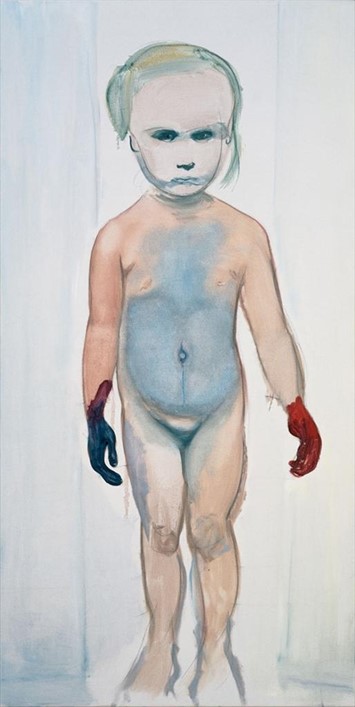A Cambridge philosophy graduate, a rising filmmaker and model, Quentin Jones features in AnOther’s JEAN D.I.Y Project. Here she shares her thoughts on her Favourite Thing, Marlene Dumas’ ghostly painting of nude child entitled The Painter...
London-based Quentin Jones is not just a pretty face. A Cambridge philosophy graduate and a rising filmmaker, Jones most recently produced the beguiling Victoria Beckham Denim stop frame animation exclusively for AnOther. Taking creative influence from a variety of sources, her series of portraits for AnOther’s JEAN D.I.Y Project in collaboration with Rag & Bone are full of playful pop art references – from Warhol’s banana to Mickey Mouse ears. There is however a deep and darker side to Jones as evidenced in her My Favourite Thing: South African artist Marlene Dumas’ ghostly painting of nude child entitled The Painter. We speak to Jones about the captivating and unsettling nature of this artwork and how Dumas inspires her own practice.
What do you find so striking about Marlene Dumas’ The Painter?
Like many of Dumas' paintings I really enjoy that the face seems quite mask-like, in that the eyes seem to peer out at us from under a muted layer of face. I like the the colour on the hands, which is very flat in contrast to the rotund figure. Likewise I find her use of clear line work under blotted ink really appealing. The subject could potentially make for a quite "chocolate box" image – the innocence of the finger painting child. But, Dumas manages with her choice of palette to avoid any sentimentality, and leaving us with something that is both captivating and unsettling.
What do you admire most about Dumas’ work?
I find the accidental nature of her work really exciting – the free movement of ink comes to define, and so often deform, the face or body. For me her work is at its most poignant when her marks simultaneously capture something her subject and skew them away from what we understand to be human. Bodies can be very two-dimensional, they become flat planes – almost like stains on walls, while the eyes of a figure are still eerily real. Maybe it's a bit like looking at an ink blot test, but one that ultimately describes the something of the human form. The accidents allow us to reflect something of our own mind onto the subjects.
Does she inspire your practice or you in any way?
Yes. In a couple of ways: I love the gestural nature of her work, and that we can see the speed with which her brush hits the canvas or paper. I find that I work best when I work quickly, allowing paint to be rough, collage to be quick, or torn – when my hands scrabble to keep up with my visual thoughts. Plus because I am working mostly with fashion imagery, I don't want my marks to be too considered or pain staking. There wouldn't be the contrast which seems to work well.
I think I am also drawn to Dumas' work because she strips some of the human nature from her subject – transforming the person into the "other". I find myself trying to turn every "other" into a human, or animal. I can't help looking at a handbag that I have to film, and wondering what face it should have. I think both directions of this thought process are interesting... but her resultant work is much more beautiful!
To view Quentin Jones’ AnOther Loves stream see here.
To view AnOther’s D.I.Y Project in collaboration with Rag & Bone: Quentin Jones see here.
Text by Lucia Davies
